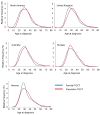Younger age-at-diagnosis for familial malignant testicular germ cell tumor
- PMID: 19609727
- PMCID: PMC2903045
- DOI: 10.1007/s10689-009-9264-6
Younger age-at-diagnosis for familial malignant testicular germ cell tumor
Abstract
One of the clinical hallmarks of hereditary cancer susceptibility disorders is a younger-than-usual age at diagnosis. Familial aggregation of testicular germ cell tumor (TGCT) has been reported, but data on whether familial TGCT cases are diagnosed at an earlier age are inconclusive. Here we compared the age at diagnosis of familial TGCT cases with that of population cases in several countries. Familial TGCT is defined as affected individuals from families with >or=2 cases of TGCT. Age at diagnosis of familial cases from the United States, Canada, United Kingdom, Australia and New Zealand, Norway, and Hungary was compared to cases identified in population-based cancer registries from the respective country, using the generalized estimation equation method. Age at diagnosis was statistically significantly younger for familial TGCT cases from North America (P = 0.024), the United Kingdom (P < 0.0001), and Australia and New Zealand (P = 0.0033) compared with population cases. When stratified by histology, the difference in age at diagnosis distribution between familial and population cases was observed for seminoma cases from North America (P = 0.002) and the United Kingdom (P < 0.0001) and non-seminoma cases from the United Kingdom (P = 0.029) and Australia and New Zealand (P = 0.0023). In summary, we found that the age at diagnosis for familial TGCT cases is, on the average, 2-3 years younger than that for the population cases in North America, United Kingdom, and Australia and New Zealand. The younger age at diagnosis might be suggestive of a genetic basis for familial TGCT.
Conflict of interest statement
The authors have no conflict of interest or financial disclosures to report.
Figures
References
-
- Ferlay J, Bray F, Pisani P, et al. GLOBOCAN 2002: Cancer incidence, mortality and prevalence worldwide. Lyon: IARC ; 2004. Press.
-
- Hemminki K, Sundquist J, Bermejo JL. Familial risks for cancer as the basis for evidence-based clinical referral and counseling. Oncologist. 2008;13:239–247. - PubMed
-
- Holzik MFL, Rapley EA, Hoekstra HJ, et al. Genetic predisposition to testicular germ-cell tumours. Lancet Oncol. 2004;5:363–371. - PubMed
Publication types
MeSH terms
Grants and funding
LinkOut - more resources
Full Text Sources
Medical


